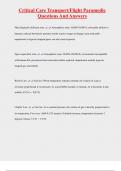Critical Care Transport/Flight Paramedic
Questions And Answers
Physiologically deficient zone Atmospheric zone; 10,000-50,000 ft; noticeable deficits to
humans; reduced barometric pressure results in poor oxygen exchange; most noticeable
impairment is hypoxia (trapped gases can also cause hypoxia)
Space equivalent zone Atmospheric zone; 50,000-250,000 ft; environment incompatible
with human life; pressurized suits and sealed cabins required; impairments include hypoxia,
trapped gas, and emboli
Boyle's Law Gas law; When temperature remains constant, the volume of a gas is
inversely proportional to its pressure; As a gas bubble ascends, it expands. As it descends, it gets
smaller; P1(V1) = P2(V2)
Charles' Law Gas law; At a constant pressure, the volume of gas is directly proportional to
its temperature; For every 1,000 ft (333 meters) of altitude increase, temperature decreases 2
degrees Celsius; V1/T1 = V2/T2
, Critical Care Transport/Flight Paramedic
Questions And Answers
Ideal Gas Law Gas law; created to explain Boyle's Law vs. Charles Law; It takes a large
amount of temperature change to affect a small amount of volume; pV = nRT (absolute pressure
of gas x volume = amount of substance x gas constant x absolute temperature)
Dalton's Law Gas law; The total pressure of a gas mixture is the sum of the individual
partial pressure of all the gas in the mixture; As altitude increases, the amount of oxygen
molecules decreases, but the percentage of molecules remains the same; Pt = P1 + P2 + P3... (Pt
= total pressure of a gas)
Henry's Law Gas law; The amount of gas in a solution is proportional to the partial
pressure of gas in contact with the liquid; decompression sickness: increased nitrogen absorbed
into the blood at depth, nitrogen "bubbles" exit the blood with rapid change in air pressure; soda
bottle: CO2 held in suspension by pressure, lid is removed and CO2 exits to equalize with
atmospheric pressure; P = KHC
Graham's Law Gas law; With temperature and pressure held constant, the relative rate of
diffusion of a gas is inversely proportional to the square roots of the density of those gases; The
less dense the gas, the more rapidly the gas will diffuse through the air; Lighter gases diffuse
more rapidly in narrowed peripheral airways (heliox); CO2 has a solubility factor 19 times
greater than O2 and will more rapidly diffuse across a membrane
, Critical Care Transport/Flight Paramedic
Questions And Answers
15 PSI/1 atm Amount of pressure at 33 ft of ocean depth
indifferent stage first of the four stages of hypoxia; sea level to 10,000 ft in altitude;
33,000-39,000 ft if breathing 100% oxygen; SpO2 of 90-95%; night vision lost 5,000 ft; slight
increase in heart rate and respiratory rate
compensatory stage second of the four stages of hypoxia; 10,000-15,000 ft in altitude;
39,000-42,000 ft if breathing 100% oxygen; SpO2 80-90%; signs and symptoms include
deceased alertness, subtle errors in judgement, fatigue, irritability, headache, tachycardia,
tachypnea, increased blood pressure, increased tidal volume, altered mental status
disturbance stage third of the four stages of hypoxia, 15,000-20,000 ft in altitude; 42,000-
45,200 ft if breathing 100% oxygen; SpO2 70-80%; signs and symptoms include fatigue,
dizziness, cyanosis, impairment, tachypnea, altered mental status, impaired central and
peripheral vision, and personality changes; period of useful consciousness is 15-20 minutes
critical stage last of the four stages of hypoxia; 20,000-23,000 ft in altitude, 45,200-
46,800 ft if breathing 100% oxygen; SpO2 60-70%; signs and symptoms include severe altered
, Critical Care Transport/Flight Paramedic
Questions And Answers
mental status, seizures, impairment, unconsciousness, severe mental and physical capacitation,
and death
hypoxic hypoxia one of the four types of hypoxia; inadequate oxygenation secondary to
reduced partial pressures of oxygen in inspired air; caused by reduced PaO2, impaired gas
exchange across the alveolar-capillary membrane, or impaired ventilation
anemic (hypemic) hypoxia one of the four types of hypoxia; inadequate tissue
oxygenation secondary to reduced to reduced oxygen-carrying capacity (from either inadequate
availability of oxygen molecules or obstructive pathology that prevents oxygen from diffusing
across alveolar membranes); caused by CO poisoning, anemia, blood loss, drugs causing
methemoglobinemia, alcohol use or abuse, COPD, pneumonia, pulmonary edema, or pulmonary
embolism
stagnant hypoxia one of the four types of hypoxia; inadequate tissue oxygenation
secondary to reduced cardiac output, pooling of blood, reduced blood flow to tissues, or
restriction of blood flow; cause by heart failure, shock, gravitational forces, positive pressure
ventilation, or pulmonary embolism




